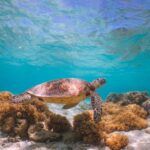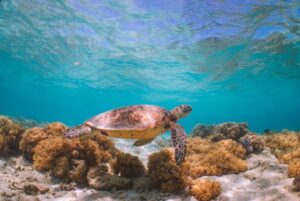 Right now, thousands of female sea turtles are migrating home to Queensland’s beaches to lay their eggs and continue the cycle of life.
Right now, thousands of female sea turtles are migrating home to Queensland’s beaches to lay their eggs and continue the cycle of life.
Despite their effort, population numbers are dwindling due to ongoing threats that include plastics pollution, fishing nets and hooks, boat strikes, feral predators, crab pots and increasing sand temperatures.
Fortunately, Queensland became the first state jurisdiction in the world to protect all marine turtle species within its borders in 1968 and has the longest history of marine turtle conservation and management in Australia (since 1932). And there are plenty of passionate organisations, people and businesses helping to protect these majestic creatures.
This World Wildlife Conservation Day (4 December), we are taking a look at how tourism meets turtle conservation here in Queensland: From a new tour that is merging ancient wisdom with modern science to protect green sea turtles to the country’s best educational centre for turtles and some of Queensland’s turtle hospitals.
Next time you visit Queensland, don’t just take a holiday to see them, but a holiday to save them.
Join the Gudjuda Saltwater People on a new Citizen Science Turtle Tour
A few kilometres north of Bowen, Traditional Owner Rangers have joined forces with one of the world’s most recognised marine research institutions, James Cook University, and the World Wildlife Fund to protect green sea turtles.
Eddie Smallwoood, Elder and Chairman of Gudjuda and Senior Ranger James Gaston, Juru Elder have conducted turtle tagging and research for over 20 years. Under a special permit they collect important biometric data such as size, weight and general health of green sea turtles, as well as tag turtles and release them back into the wild. This data is then fed into state, national and international databases and shared with the Department of Agriculture and Fisheries to gain important insights into the species to help protect it.
Now, for the first time, budding scientists can join in and help out by signing up to Gujuda’s four-hour Turtle Rescue Tour. Led by Eddie and James, visitors board a boat in Bowen at the top of the Whitsundays region and venture out to help locate and safely catch turtles in order to collect biometric data, before tagging and releasing them back into the water.
Help protect endangered loggerhead turtles at Mon Repos Conservation Park
Mon Repos, near Bundaberg, is Queensland’s turtle mecca. Each year, between November and January, hundreds of female turtles come back to the beach at Mon Repos Conservation Park to nest and rest, making it the home of the most significant population of endangered loggerhead turtles in the South Pacific. Six weeks later (from January to March), the eggs hatch with hundreds of baby turtles making a dash for the ocean.
Mon Repos is also home to the country’s best educational centre for marine turtles, the Mon Repos Turtle Centre run by Queensland Parks and Wildlife Service (QPWS). Here, visitors can learn about the conservation program, research and monitoring conducted on site as part of the Queensland Turtle Conservation project since 1968. The Centre reopened late last year after a $22 million refurbishment that saw new touch screens, interpretive signage, a café and an immersive theatre added to the facility.
From November to March, visitors also have the chance to join one of the QPWS Rangers for a nightly Turtle Encounter to witness turtles laying eggs or hatching (depending on the season).
Ongoing successful breeding at Mon Repos is vital to the survival of the loggerhead species, which is why Rangers are especially vigilant to ensure both nesting and hatching turtles are kept safe.
Want to linger a little longer? Visitors can join the crusade by signing up for the Queensland Turtle Conservation Project as volunteers to assist with research and monitoring, or by signing up to support the Mon Repos Turtle Centre.
Visit Queensland’s Turtle Hospitals: Fitzroy Island, Cairns and Townsville
The Cairns Turtle Rehabilitation Centre is a not-for-profit organisation dedicated to protecting, caring for and rehabilitating sick and injured marine turtles brought in from the Great Barrier Reef and Cape York Peninsula with the aim to release them back into their natural habitat.
Founded by Paul Barnes and Jennie Gilbert in 2000, the Centre has rescued and rehabilitated more than 200 turtles across its three facilities – the triage facilities at Cairns Aquarium, an intensive care and research facility at James Cook University and the Fitzroy Island Turtle Rehabilitation Centre which cares for turtles in their final stage of their rehabilitation, before being released.
Every day, staff care for these creatures by feeding them, cleaning their tanks, checking their health, and administering medicine if required. Turtles can stay in their care from anywhere between a few months to a few years. Once they are released back into the ocean, wildlife warriors from around the globe can follow their journey in real-time via the online Reef Tracks platform.
Visitors can join daily educational tours at the Fitzroy Island Turtle Rehabilitation Centre to learn more about the turtles in care and watch on as staff care for the little patients.
Further south in Townsville at Reef HQ Aquarium, the world’s largest living coral reef aquarium, the adjacent Turtle Hospital also cares for and rehabilitates sick and injured marine turtles. Over the past 11 years, the hospital cared for nearly 300 turtles.
At this point in time, the hospital is closed due to a $41 million upgrade of the facilities at Reef HQ Aquarium and the Turtle Hospital in 2021. It is anticipated that Reef HQ, including the turtle hospital will re-open in 2022.
Want to linger a little longer? For a minimum of one week, visitors can volunteer to help care for the patients at Fitzroy Island Turtle Rehabilitation Centre. Based in Cairns, the program includes daily ferry transfers to the island on the Great Barrier Reef (arguably the world’s most scenic 45-minute commute) and rostered days off to explore the reef and rainforest in Tropical North Queensland.
Feeling inspired?
If you want to find out what else you can do to help sea turtles in Queensland, visit queensland.com















